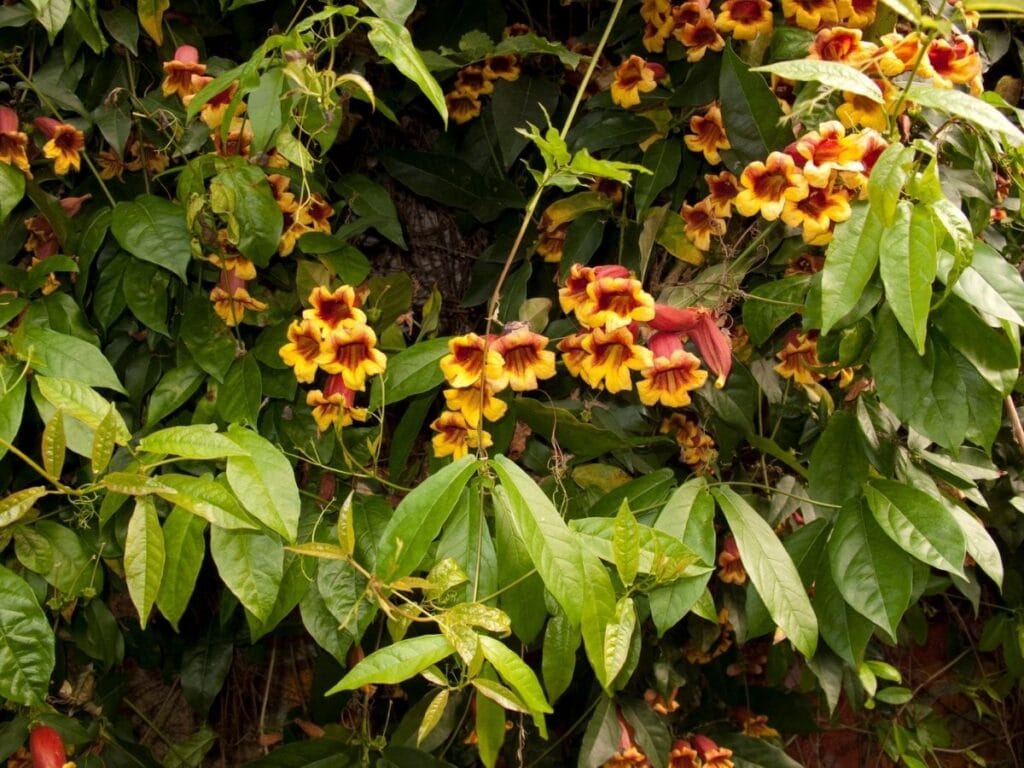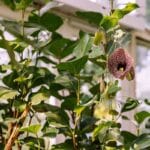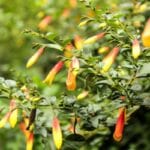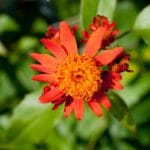The crossvine (Bignonia capreolata) is a great plant to incorporate in various landscape types, which is made possible by its growth habits and morphology. Also, it attracts different kinds of birds and butterflies. Read on to know more.
Botanical Information
Coming from the Trumpet-Creeper family or Bignoniaceae family, Bignonia capreolata is commonly known as the crossvine, trumpet shaped flowers, bignonia crossvine, or cross vine. The genus, Bignonia, is coined to honor Louis’ XIV librarian, Abbe Jean Paul Bignon.
On the other hand, the species pertains to having tendrils. Moreover, the common name is from the Greek cross pattern seen when the vine’s stems are cross-sectioned.
Spatial Distribution
The crossvine plant is native to Eastern America and Southern Ontario, wherein they are often found near forest uplands, limestone ridges, and areas beside or under fences. Given its natural habitat, the vine thrives in USDA zones 5 through 9.
Growth Habits
Same as its close relatives from the Bignoniaceae family, the crossvine is an evergreen climbing perennial. Thanks to its vast growth, it reaches up to 50 feet in height and 9 feet wide. Moreover, this woody vine has extra support because of its tendrils.
These are specialized stem structures that help the vine cling to supporting infrastructures. In areas wherein support is not available, the crossvine crawls up to trees and shrubs.
Leaves
Attached to the glossy dark green stems are red violet-tinged leaves. Each oblong leaf extends for up to 6 inches and has tendrils with sticky disks sticking out. Moreover, the leaves are waxy like their stems. The foliage is arranged oppositely or pinnately.

Flowers
Crossvine flowers are its main attraction. Each one is trumpet-shaped and two-toned. The elongated parts of the flower are colored red or burgundy and transition to a bright yellow on the lobes. The crossvines produce flowers in clusters. These beautiful crossvine blooms are prolific during Spring and Winter.
Fruit and Seeds
As a leguminous vine, the plant produces green pods which extend up to 7 inches. Usually, these fruits are prominent during summer and sometimes even fall.
Grow and Care Tips for Bignonia Capreolata
Sun Requirement
The crossvine thrives in areas with full or partial exposure to the sun. In forested areas, they also grow under canopies wherein the sunlight is blotchy. Although, remember to give at least 6 hours of uninterrupted sun exposure during the blooming season.
This will help the evergreen vine grow more beautiful and colorful flowers. Also, it is recommended to plant this vine under full sun to optimize the number and quality of vine blooms.
Water Requirement
Frequent watering in moderate amounts is what this trumpet vine loves. Sometimes, it prefers having slightly less moisture but not to the point of wilting.
Temperature and Humidity
As a sun-loving flowering plant, the crossvine prefers to grow in a warm and humid environment.
Soil Requirement
A organically rich soil with organic matter, good drainage, and excellent water-holding capacity is the best for this vine. In terms of soil mix, loam and sand, which promote well-drained soil, are the most suitable. Moreover, the pH of the soil should range from 6 to 8, making it neutral. Aside from these, the appropriate planting distance of 12 to 24 feet by 24 to 6 feet should be implemented.
Fertilizer Crossvine Requirement
Application of fertilizer is not necessary but may be done regularly. This activity may be done using a slow-release complete fertilizer or organic plant food.
Additionally, when choosing to fertilize crossvine, it is essential to avoid the application of nitrogen-rich fertilizers during the flowering phase. The reason for this is that the nitrogen-rich fertilizer will promote the production of foliage rather than flowers.

Maintenance Activities
Pruning and training are the principal maintenance activities for the crossvines. Pruning involves the removal of dead and damaged plant parts, which helps rejuvenate the plant and lessen its susceptibility to diseases. Also, pruning helps train the vine.
The vine is trained by providing a sturdy supporting structure that could hold up the plant. It is where the vine will be crawling, growing, and taking form. Remember to pick strong support to ensure that there will not be any mishaps that could lead to accidents in the landscape.
Propagation
There are two main planting materials used to reproduce the crossvine, seeds and stem cuttings. The seeds are often dispersed naturally by wildlife and water. However, it is also possible to harvest the plant seeds from the pods and plant them in a seedbed.
On the other hand, stem cuttings are also harvested with the help of having a keen eye and good judgment. The harvester should determine the stems that are not too old but not too young. The stems should be thick enough to support a few leaves and develop a stable root system.
In either planting material, it is essential to prepare the growing media. The most suitable soil for sowing is the medium with high organic matter content, good drainage, high water holding capacity, and is highly porous.
Also, remember to place the seedlings and cuttings in a moist and warm area. Moisture is recommended to be applied by misting. This watering method will help the seedlings get uniform amounts of water.
After the seedlings and cuttings develop an established root system and numerous leaves, transplanting may be done. It can be planted in either a container or somewhere in the landscape, keeping in mind the requirements mentioned in the former parts of this article.
Function In the Landscape
The crossvine plant serves multiple functions in the landscape as an ornamental vine. It is often utilized as a foundation, specimen, and screen plant. As a fast-growing vine, it is also used in vertical landscapes.
Its foliage provides a rough texture that could be used in contrast to plants with finer leaves. Moreover, when this great plant is utilized as a screen or shade, they are left to cling to structures such as fences, stakes, arbors, and trellises.
They serve these functions efficiently because of their appearance and resistance to drought tolerant, cold hardy, and compaction. Aside from the mentioned landscape functions, it makes a good addition for different garden themes like butterfly, winter, and children’s gardens.
Ornamental cultivars
‘Shalimar Red’
This cultivar is characterized by having red flowers that elongate from 1 to 2 inches.
‘Tangerine Beauty’
This cultivar’s distinguishing characteristics are having evergreen foliage that changes from green to red-violet during fall and 2-inch red-orange flowers.
‘Helen Fredel’
What makes this cultivar is differentiated by its yellow flowers.
‘Dragon Lady’
The Dragon Lady cultivar produces attention-grabbing light pink and red flowers.
‘Jekyll’
This cultivar is preferred by gardeners that like flowers with terracotta outer color and a yellow-orange center.
‘Atrosanguinea’
This cultivar stands out with its dark red flowers.
FAQs
Is the crossvine invasive?
No, this vine is not invasive despite being a fast-grower.
Is the crossvine poisonous to dogs?
No studies are supporting the toxicity of this vine to dogs. However, reports are stating that it is harmful to pets when ingested in large amounts.
Is the crossvine Evergreen?
Yes, this vine has its foliage all year. However, some cultivars change their foliage color during specific seasons.
Can Crossvine be propagated?
Yes, Crossvine can be propagated. You can propagate crossvine cultivars in different ways: stem cuttings or seeds. Stem cuttings are a standard and efficient method for propagating this vine.
For more vines to grow, see our list of vine plants.
*image by simonapavan/depositphotos
References
Reference List:
https://www.itis.gov/servlet/SingleRpt/SingleRpt?search_topic=TSN&search_value=34307#null
https://www.fs.fed.us/wildflowers/plant-of-the-week/Bignonia_capreolata.shtml
https://plants.ncwildflower.org/plant_galleries/details/bignonia-capreolata
https://aggie-horticulture.tamu.edu/ornamentals/nativeshrubs/bignoniacapreolat.htm
Close






